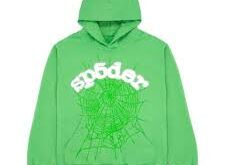Related Articles
Building a sustainable wardrobe isn’t just a fashion trend; it’s a conscious effort to minimize waste, reduce environmental impact, and support Sp5der ethical practices in the fashion industry. As a staple in casual fashion, the hoodie has evolved into an essential piece of clothing that balances comfort with style. However, with the rise of fast fashion, it’s more important than ever to be mindful of how we shop for hoodies and other apparel.
This guide will walk you through the steps of mindful hoodie shopping, helping you curate a wardrobe that is not only fashionable but also environmentally conscious and sustainable.
Why Mindful Shopping MattersMindful shopping isn’t just about buying less—it’s about making smarter, more thoughtful choices. When you adopt a mindful approach to hoodie shopping, you focus on the quality, longevity, and production ethics of the garments you choose sp5-der.com. By doing so, you can build a wardrobe that reflects your values, reduces your carbon footprint, and helps you save money in the long run.
When purchasing hoodies mindfully, you’re supporting companies that prioritize ethical labor practices, environmentally friendly production methods, and high-quality materials. These considerations ensure that the hoodies in your wardrobe are durable, stylish, and sustainable.
What to Look for in a Sustainable Hoodie
To build a sustainable hoodie collection, you need to be informed about what makes a hoodie eco-friendly. Sustainable hoodies differ from conventional ones in several ways, including the materials used, production processes, and the brand’s commitment to social responsibility.
First, opt for hoodies made from organic or recycled materials. Organic cotton, hemp, bamboo, and Tencel are great alternatives to traditional cotton, which requires massive amounts of water and pesticides to produce. Recycled polyester and other eco-friendly synthetic fibers are also good choices, as they reduce waste by reusing existing materials.
Second, pay attention to the production practices of the brand. Ethical manufacturing involves fair labor conditions, transparent supply chains, and efforts to minimize water, energy, and chemical use during production. Certifications like Fair Trade, Global Organic Textile Standard (GOTS), and OEKO-TEX can help you identify brands that adhere to these standards.
The Importance of Durability and Quality
When shopping for hoodies, always prioritize durability and quality. While fast fashion brands may offer cheap prices, their garments are often made to last only a few seasons, leading to frequent replacements and increased waste. On the other hand, investing in a high-quality hoodie will ensure that it lasts for years, reducing the need to purchase new ones frequently.
A well-made hoodie is one that is constructed with durable stitching, high-quality materials, and attention to detail. These factors contribute to its ability to withstand wear and tear over time. While the initial cost may be higher, you’ll ultimately save money by reducing the frequency of replacement purchases.
In addition to durability, consider how versatile the hoodie is. Can it be worn across different seasons? Can it be styled in various ways to fit different occasions? A versatile hoodie will have a longer lifespan in your wardrobe, reducing the need for excessive shopping.
Choosing Ethical Brands for Your Hoodie Collection
One of the most significant aspects of mindful shopping is supporting ethical brands. These are companies that are transparent about their supply chains, use sustainable materials, and ensure fair labor practices throughout their production process. While fast fashion brands may prioritize profit over people and the environment, ethical brands strive to make a positive impact comme-des-cargons.com.
Research brands before making a purchase to ensure that they align with your values. Many brands now openly share information about their sustainability initiatives, including the materials they use, the conditions in which their workers operate, and their overall environmental footprint. Choosing to support these brands not only helps build a sustainable wardrobe but also sends a message to the fashion industry that consumers demand better practices.
Embracing Minimalism: Less is More
When it comes to mindful hoodie shopping, minimalism plays a crucial role. Instead of accumulating an overwhelming number of hoodies, focus on curating a smaller, high-quality collection that meets your needs. By adopting a minimalist approach, you reduce clutter in your wardrobe and limit your impact on the environment.
Start by evaluating your current hoodie collection. Are there pieces you no longer wear? Donate or recycle hoodies that are still in good condition but no longer suit your style. Then, focus on purchasing only a few well-made, versatile hoodies that can be worn in various settings. This way, you’re not only cutting down on consumption but also simplifying your wardrobe to include only items that bring value to your daily life.
Minimalism in fashion also encourages you to be more thoughtful about each purchase. Rather than buying impulsively, ask yourself whether the hoodie you’re considering will truly enhance your wardrobe and align with your sustainability goals.
Mindful Shopping: Avoiding Impulse Purchases
Impulse purchases are one of the main contributors to overconsumption and waste. The fast fashion industry thrives on the “buy now, think later” mentality, enticing consumers with frequent new arrivals and low prices. To build a sustainable wardrobe, it’s essential to break away from this mindset and adopt a more intentional approach to shopping.
Before purchasing a hoodie, consider whether it aligns with your personal style, if you’ll wear it frequently, and how it fits into your existing wardrobe. Take your time to research the product and the brand to ensure it meets your sustainability standards. By resisting the urge to buy on impulse, you’ll make more thoughtful, purposeful decisions that contribute to a sustainable wardrobe.
Supporting Local and Independent Hoodie Brands
Supporting local and independent hoodie brands is another excellent way to build a sustainable wardrobe. These brands often have smaller production runs, which reduces waste and overproduction. They may also source their materials locally and use more sustainable production methods, as they are not driven by the same mass-production pressures as large corporations.
Local and independent brands are more likely to prioritize quality and ethical labor practices, given that their reputation relies heavily on customer satisfaction and transparency. When you shop from these brands, you not only reduce your carbon footprint by supporting local economies but also contribute to the preservation of traditional craftsmanship and sustainable business models.
The Role of Secondhand Shopping
Secondhand shopping is an excellent way to build a sustainable wardrobe without contributing to the demand for new resources. By purchasing pre-owned hoodies, you’re giving new life to garments that might otherwise end up in landfills. Thrift stores, consignment shops, and online platforms like Depop or Poshmark offer a wide range of secondhand hoodies in good condition.
In addition to being an eco-friendly option, secondhand shopping allows you to find unique, vintage pieces that aren’t available in mainstream stores. It’s also a more affordable way to build a sustainable wardrobe, as secondhand items are typically priced lower than new garments.
When buying secondhand hoodies, make sure to check for signs of wear and tear to ensure the garment will last. Minor imperfections like loose threads or small stains can often be fixed, but it’s essential to invest in pieces that are still durable and functional.
Taking Care of Your Hoodies for Longevity
Building a sustainable wardrobe goes beyond making mindful purchases—it also involves caring for your clothing to ensure it lasts as long as possible. Proper care can extend the lifespan of your hoodies, reducing the need to replace them frequently and thus lowering your overall consumption.
Always follow the care instructions provided on the garment’s label, and consider air-drying your hoodies instead of using a dryer, which can wear down the fabric over time. Washing your hoodies in cold water and using eco-friendly detergents can also help preserve the fabric’s quality and reduce the environmental impact of laundry.
For hoodies made from delicate or high-quality materials, consider spot-cleaning instead of washing the entire garment. This will help reduce the frequency of washes and keep the material looking new for longer. Additionally, proper storage, such as folding your hoodies neatly or hanging them on padded hangers, will help maintain their shape and structure over time.
Conclusion:
Mindful hoodie shopping is about making intentional, thoughtful choices that reflect your values and reduce your environmental impact. By focusing on quality, durability, and ethical production practices, you can build a hoodie collection that is both stylish and sustainable.
Whether you’re supporting ethical brands, choosing eco-friendly materials, or embracing secondhand shopping, every decision you make contributes to a more sustainable fashion industry. With each hoodie you purchase, you’re taking a step toward a wardrobe that is kinder to the planet and more aligned with your personal values. So, take your time, shop mindfully, and enjoy the process of building a sustainable hoodie collection that you’ll love for years to come.



